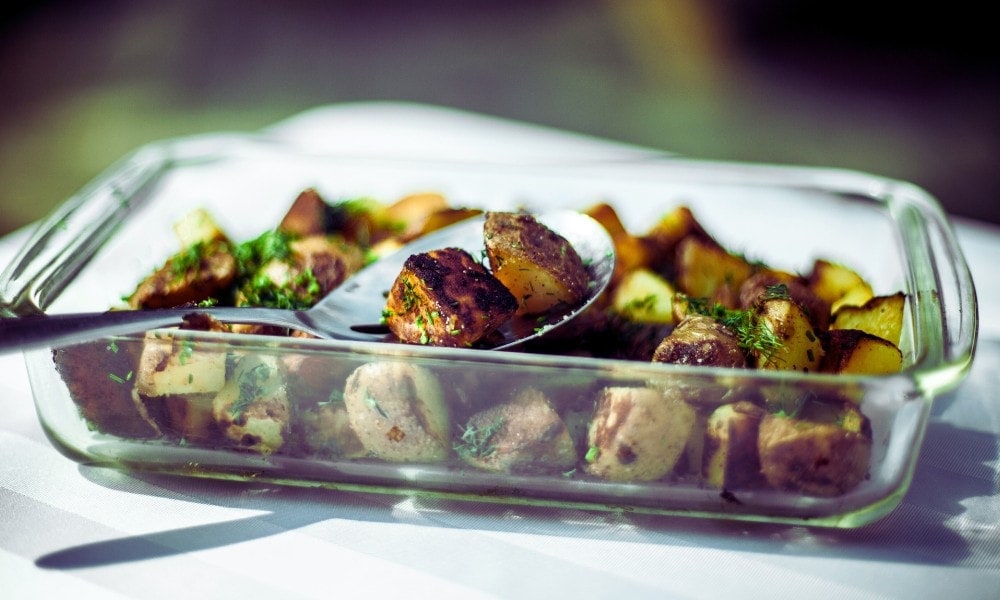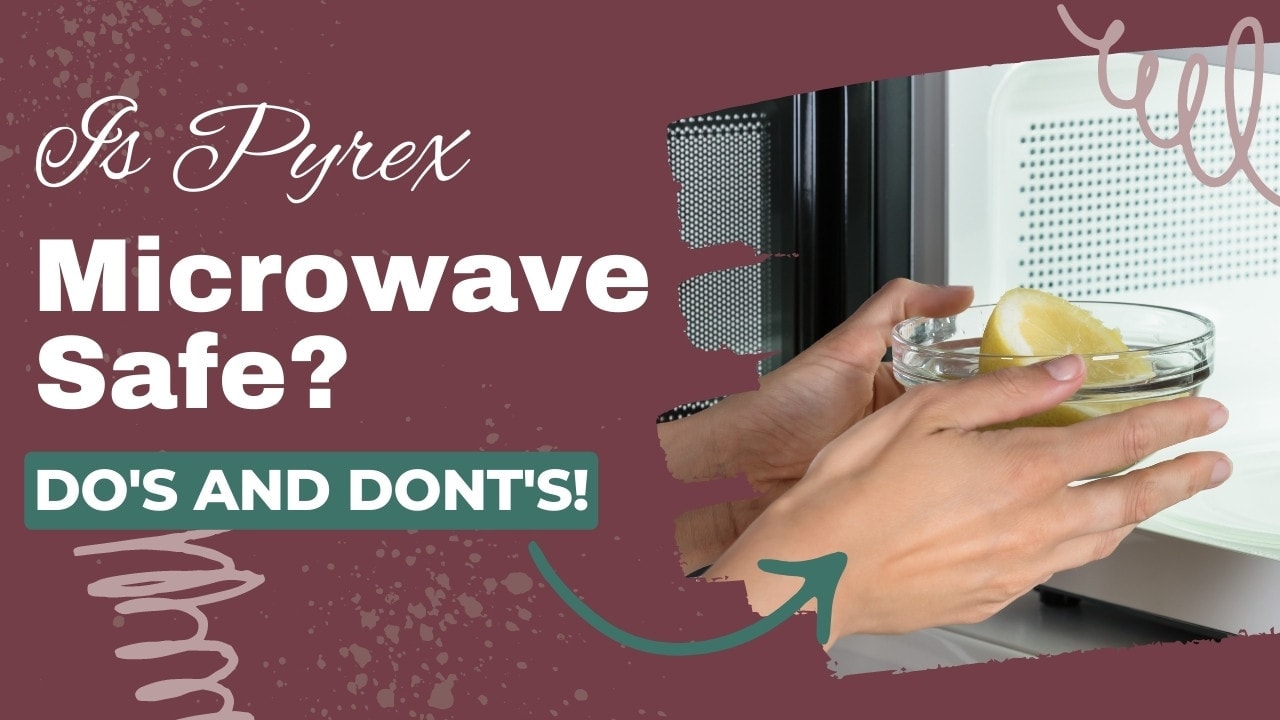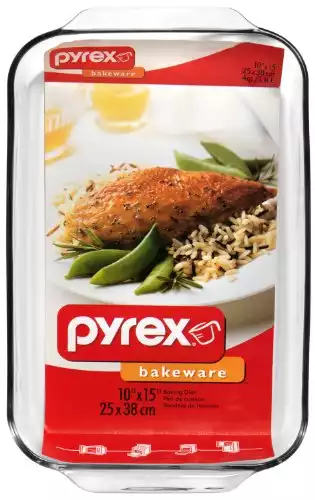Many of us have a habit of grabbing our Pyrex dish of leftovers, popping it into the microwave, and digging in. But is Pyrex microwave-safe?
Accidentally microwaving the wrong container and having it crack or shatter on you is startling – not to mention a huge mess and waste of food! Will this happen with Pyrex containers – or is there a way to prevent it?
By the end of this article, you will know the following:
Is Pyrex Microwave Safe?
Yes, Pyrex is safe to use in the microwave. Pyrex is made from borosilicate glass or tempered glass, which has specially designed heat-resistant properties. But do not heat fridge-cold Pyrex, and do not place hot Pyrex onto cold surfaces, or this may shatter the glass.
The BPA-free plastic lids and the glass lids are also microwave-safe.
Keep on reading to learn how to properly use Pyrex containers in the microwave.
What is Pyrex?
So we know that Pyrex is microwave safe, but what exactly is this handy material, and what makes it better than regular glass?
As Mat the Sci Guy explains in the video below, Pyrex is a brand name for strong, heat-resistant glass products that are suitable for use in the microwave in the oven. Their products include glass measuring cups and various shapes of cookware with or without lids. The brand has become such a household name that it is used colloquially to refer to any heatproof glassware, even if it’s made by a different brand.
Today, I’m going to deep dive into the real deal to discover its magical heat-resistant properties.
“Regular” glass is known as soda-lime glass because it is made from calcium and sodium as well as silicone oxide. This is the glass that you will find in windows and other regular glassware. Soda-lime glass is not heat resistant.
Pyrex containers are heat resistant, because they’re made of either borosilicate glass or tempered glass.
When the company was founded in 1915, all of the Pyrex products were made from borosilicate glass – but since 1998 the products in the US are now made from tempered glass. Which material the Pyrex in your stores is made from depends on where in the world you are shopping as it’s a regional difference. Pyrex is produced all over the world including France, Australia, the UK, and China. The US factory is in Charleroi, Pennsylvania.
Let’s look at these two materials and how they differ:
Borosilicate Glass
The way that borosilicate glass works is very “sciency” – but I’ll try to break it down in a simple way. Basically, boron is added to the molten glass (made from silicone oxide), which strengthens the bonds within the glass on an atomic level. This makes the glass very durable and expands less when heated. This option is more expensive to produce due to the intense heat required, which is a significant reason why the company shifted to tempered glass.
Pyrex made from borosilicate glass is still produced in Africa and some parts of Europe – but tempered glass is more prevalent everywhere else in the world. It’s easy to tell which one you’re buying if it’s new because it will be written on the packaging.

But if you find a piece of glass bakeware in a thrift store (this is a great place to find well-made cookware on a budget) there is an easy way to tell if it is soda-lime glass or borosilicate glass. The borosilicate glass will have no color at all, at any angle, whereas the soda-lime glass will have a slightly blue hue. This may not tell you whether or not the glass is tempered, though. Tempered glass will have smoother edges than regular soda-lime glass.
Tempered Glass
Tempered glass is created when regular glass is heat treated.
The tempering process involves heating the glass and then rapidly cooling it so the outside cools more quickly than the inside. The tension created between these two layers makes the glass incredibly tough and more thermally resistant. Another huge upside to tempered glass is that, when it does break, it shatters in a safer way. Instead of large, dangerous shards, the cookware will shatter into small chunks of glass that are far less easy to cut yourself on.
This option is cheaper than borosilicate glass because it requires lower temperatures to make but results in glass that is nearly as strong.
Tempered all is considered to be the more eco-friendly option because it requires less heat to make, which reduces air pollution. The products are also more easily recycled.
Pyrex and Thermal Shock
Pyrex’s products are known for having a very high resistance to thermal shock in compared to regular glass. Thermal shock is a phenomenon that happens when glass, or other materials like ceramic, experience sudden expansion or shrinkage due to a drastic temperature change.
If a material is heated slowly, it will warm up evenly, which prevents cracking. But when something is heated quickly, like in a microwave, it can cause hot spots that heat up more quickly than the colder areas The opposing forces of expanding and static glass is what cause the shattering. On the other hand, if the materials cool too quickly, it will cause uneven shrinkage, which will have the same effect.

Pyrex has a shock resistance from -104°F to 428°F, which makes it generally safe for everyday cooking. This material is so tough that Pyrex is the standard material for use in scientific laboratories, where they are exposed to high temperatures.
The stories of Pyrex exploding in your microwave come from a few drastic cases where the thermal shock has been too much even for the borosilicate or tempered glass. Perhaps there was a manufacturing defect, like an air bubble in the glass
✅ Good Heat Conduction
✅ Safe for oven, microwave, freezer, and dishwasher
✅ Made in the USA
Remember, though, Pyrex is not indestructible! There is always a risk of your it cracking if you don’t take the right precautions. So let’s get into some ways to microwave Pyrex safely.
How to Microwave Pyrex Safely
So, I know so far we have only discussed how safe Pyrex is to microwave but there are some risks I need to bring to your attention.
The only risk to microwaving Pyrex is shocking the glass, which will cause it to shatter. This will only happen when a swift change of temperature takes place, and there are steps you can do that will reduce the likelihood.
Here is how I recommend microwaving Pyrex safely:
I like to remove the dish from the freezer the night before and leave it on a plate in the fridge to defrost. Then I remove it from the fridge for at least 30 minutes before reheating it in the microwave. I don’t recommend thawing using a microwave in most cases but especially when you’re using Pyrex.
As I mentioned above, thermal shock can also occur when the glass cools down too quickly. Putting your hot Pyrex onto a cold countertop can cause the Pyrex to shatter as the base suddenly cools. The best way to remedy this is to place the dish or jug onto a dishcloth or pot holder on your countertop to smooth the heat transition.
What About Other Brands of Glass Containers?
There are a lot of generic bakeware options on the market that can be just as good as Pyrex but you need to be very careful about reading the packaging. Its very easy to confuse regular glass with tempered glass at first glance and getting these confused can end in huge mess in your microwave. When you buy off-brand glass bakeware you need to check on the packaging that it is made from tempered glass and whether or not it is oven and microwave safe before you buy it.
Conclusion
Although there are a few precautions you need to take, Pyrex is safe to microwave. This is because it is made from powerful borosilicate or tempered glass that has a high level of heat resistance. Now go off and microwave your leftovers with the peace of mind that it’s not going to explode on you!










